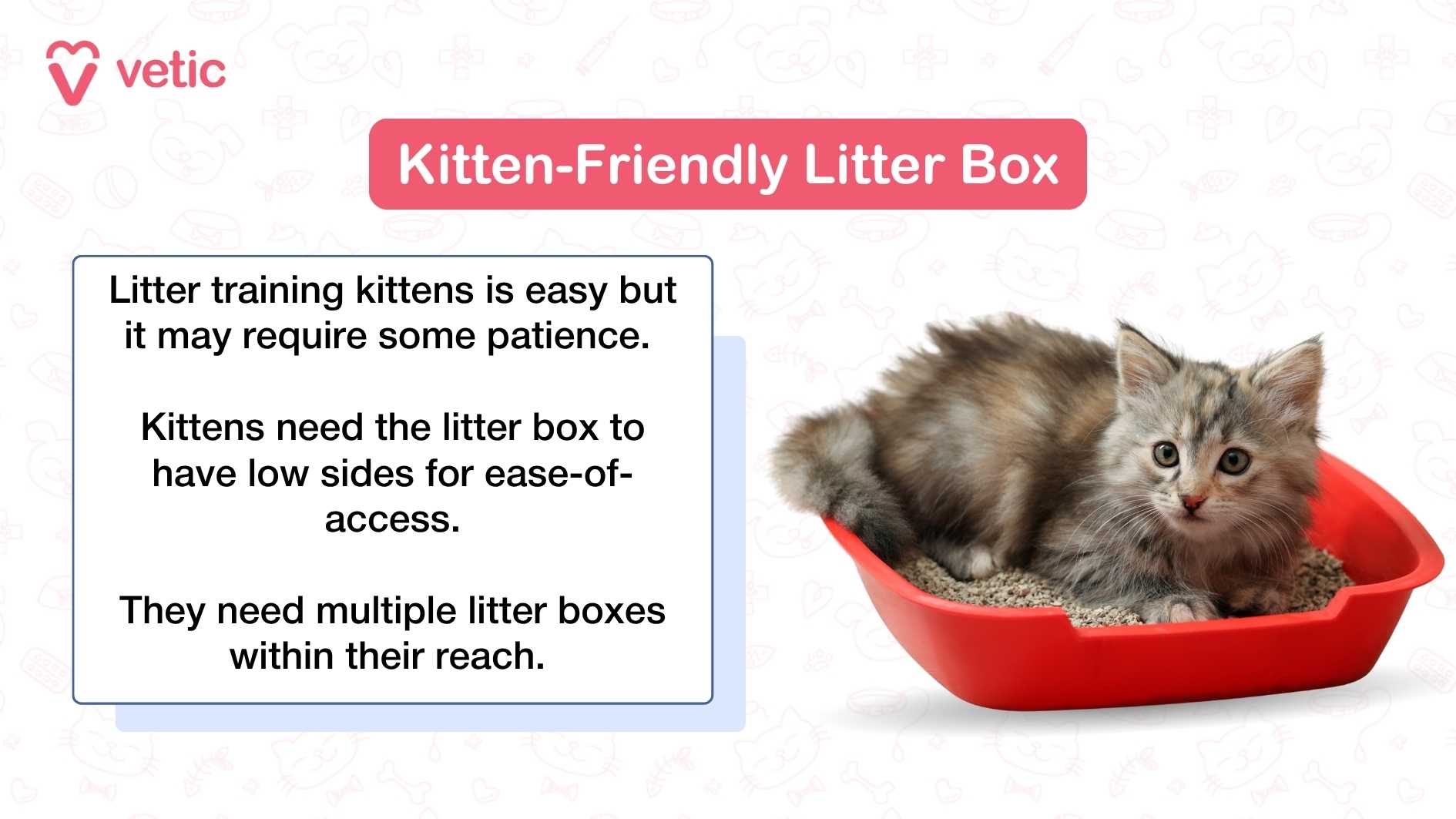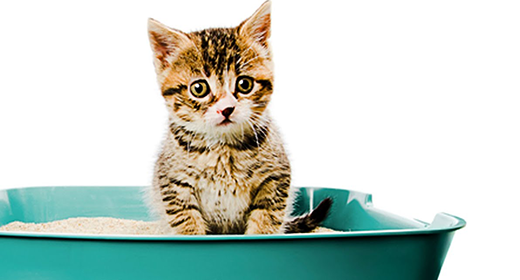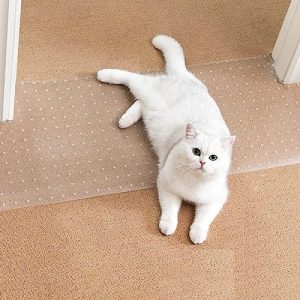Training your cat to use a kitty litter box might seem tricky, but it doesn’t have to be. Imagine a clean home where your furry friend knows exactly where to go, saving you time and stress.
You can make this happen with a few simple steps. Whether you have a new kitten or an older cat, this guide will help you teach your pet to use the litter box quickly and easily. Keep reading, and you’ll discover how to turn this essential habit into a smooth, hassle-free routine for both you and your cat.

Credit: vetic.in
Choosing The Right Litter Box
Choosing the right litter box is key to training your cat to use the kitty litter. Cats are picky about their bathroom habits. The right box makes the process easier and cleaner. It also helps your cat feel safe and comfortable.
Types Of Litter Boxes
There are many types of litter boxes to pick from. Each suits different cats and homes. Here are common options:
- Open Litter Boxes:Easy to access and clean. Cats like the open space.
- Covered Litter Boxes:Provide privacy and reduce odor. Some cats may dislike the enclosed space.
- Self-Cleaning Litter Boxes:Automatically remove waste. Good for busy owners but can be noisy.
- Disposable Litter Boxes:Convenient for travel or short-term use. Not eco-friendly for long term.
Choose a type your cat feels secure using. Observe your cat’s preferences if possible.
Size And Placement Tips
Pick a litter box large enough for your cat to turn around easily. A small box can cause accidents.
Place the box in a quiet, low-traffic area. Cats prefer privacy when they go.
Avoid spots near noisy appliances or busy rooms. Keep the box away from their food and water bowls.
Ensure the box is easy for your cat to enter and exit. Senior cats may need lower sides.
Picking The Best Kitty Litter
Picking the best kitty litter is a key step in training your cat to use the litter box consistently. The right litter can make your cat feel comfortable and encourage them to use the box without hesitation. It also helps keep your home fresh and clean, which benefits both you and your furry friend.
Popular Litter Materials
You have several options when choosing litter material, each with its own benefits and drawbacks.
- Clay-Based Litter:This is the most common and affordable type. It clumps well, making cleaning easier, but it can be dusty and heavy.
- Silica Gel Litter:Made from tiny crystals, this litter controls odor effectively and lasts longer between changes. However, some cats dislike the texture.
- Biodegradable Litter:Options like corn, wheat, or pine fall into this category. They are eco-friendly and often less dusty, but they may not clump as well.
Think about your cat’s preferences and your cleaning routine. Have you noticed your cat avoiding the box? Sometimes switching the litter material can make a big difference.
Scented Vs Unscented Options
Scented litters promise to mask odors, but not all cats like the added fragrances. Some may even avoid the litter box if the smell is too strong.
Unscented litter is usually safer for sensitive noses and helps you detect any unusual odors that could signal health issues. If your cat is new to litter training, unscented is often the best starting point.
Ask yourself: Does your cat seem bothered by strong smells? Trying unscented litter first can help you avoid training setbacks and make the experience more comfortable for your cat.
Introducing Your Cat To The Litter Box
Introducing your cat to the litter box is a crucial step in their training journey. It sets the foundation for good bathroom habits and helps avoid messes around your home. You want your cat to feel comfortable and curious, not stressed or confused.
Initial Placement Strategies
Choose a quiet, low-traffic spot for the litter box. Cats prefer privacy when they do their business, so avoid noisy areas or places near their food and water bowls.
Think about accessibility. If you have a kitten or an older cat, the box should be easy to reach without obstacles. I’ve seen cats avoid boxes placed in hard-to-find spots, leading to accidents elsewhere.
Place multiple boxes if you have more than one cat. A good rule is one box per cat plus one extra. This reduces competition and keeps everyone happy.
Encouraging Exploration
Let your cat explore the litter box at their own pace. Gently place them inside after meals or naps, times when they are naturally inclined to go.
Use positive reinforcement. Praise your cat or offer a small treat when they show interest or use the box. This creates a positive association.
Never force or punish your cat. Pressure can cause fear or aversion. Instead, keep the area clean and fresh to invite repeated visits.

Credit: www.iams-india.com
Establishing A Consistent Routine
Training your cat to use a litter box involves establishing a consistent routine. Cats thrive on predictability and structure. Setting a regular pattern helps them understand when and where to go. Consistency makes the transition smoother for both you and your cat.
Regular Cleaning Schedule
A clean litter box attracts your cat. Scoop out waste daily to prevent odors. A dirty box may discourage use. Replace litter completely once a week. Fresh litter encourages regular use. Keep the box in a quiet, accessible area. Avoid noisy or busy locations.
Feeding And Litter Timing
Feed your cat at the same time each day. Cats often use the litter box after meals. Observe your cat’s habits. Set litter box time accordingly. Consistent feeding helps predict litter needs. Adjust the schedule based on your cat’s routine.
Handling Common Challenges
Training a cat to use the kitty litter can come with some challenges. Patience and consistency help overcome these issues. Understanding common problems makes training smoother. Let’s explore how to handle avoidance and manage accidents effectively.
Dealing With Avoidance
Some cats may avoid the litter box at first. The box might feel strange or uncomfortable. Keep the litter box clean and in a quiet spot. Use unscented, soft litter that cats like. Place the cat gently in the box after meals. Reward with praise or treats when your cat uses it. Avoid punishment; it only makes avoidance worse.
Managing Accidents
Accidents happen during training. Do not scold your cat for mistakes. Clean the area thoroughly to remove odors. Use an enzyme cleaner to stop re-marking. Observe if the box location or litter type needs change. Increase the number of litter boxes if you have multiple cats. Consistent routine helps reduce accidents over time.
Positive Reinforcement Techniques
Positive reinforcement techniques help your cat learn faster. They create a happy link between using the litter and rewards. This builds good habits without fear or punishment. Your cat feels safe and motivated to repeat the right behavior.
Rewarding Good Behavior
Catch your cat using the litter. Give immediate rewards to show approval. Timing is key. Rewards teach your cat what action you like.
Rewards can be:
- Soft petting
- Gentle praise
- Extra playtime
These rewards help your cat connect the litter box with positive feelings. Avoid scolding or negative tones, which cause confusion and fear.
Using Treats And Praise
Treats motivate cats to repeat good actions. Offer small, tasty treats after they use the litter. Keep treats healthy and special.
Combine treats with kind words like “good job” or “well done.” Your voice should sound happy and warm.
Repeat this process consistently. Your cat will soon choose the litter box by itself. Patience and kindness speed up learning.
When To Seek Professional Help
Training a cat to use the litter box usually goes smoothly. Sometimes, challenges arise that need expert help. Knowing when to seek professional advice can save time and stress. It also ensures your cat stays healthy and happy during training.
Signs Of Medical Issues
Watch for signs that may show health problems. These include:
- Frequent accidents outside the litter box
- Straining or crying during bathroom use
- Blood in urine or stool
- Sudden changes in bathroom habits
- Excessive licking of private areas
- Loss of appetite or weight
Such symptoms might mean your cat feels pain or discomfort. Medical issues can make litter training harder.
Consulting A Veterinarian
Visit a vet if you notice any medical signs or ongoing litter problems. A vet can:
- Diagnose infections or diseases
- Provide pain relief or treatment
- Offer advice on litter training methods
- Recommend behavior specialists if needed
Early veterinary care helps your cat recover quickly. It improves chances of successful litter training.

Credit: teketrek.net
Frequently Asked Questions
How Long Does It Take To Train A Cat To Use Litter?
Training usually takes one to two weeks with consistent guidance. Patience and routine are key for faster learning. Reward your cat to encourage good behavior. Some cats may learn quicker than others.
What Is The Best Type Of Kitty Litter For Training?
Clumping, unscented clay litter is ideal for training. It is easy to clean and familiar to most cats. Avoid scented litters initially, as they may deter cats. Choose a litter that your cat prefers.
How Can I Encourage My Cat To Use The Litter Box?
Place your cat in the litter box after meals and naps. Praise or reward your cat when they use it correctly. Keep the box clean to prevent avoidance. Consistency helps build good litter habits.
What Should I Do If My Cat Avoids The Litter Box?
First, check if the box is clean and accessible. Consider medical issues and consult a vet if needed. Try changing the litter type or box location. Use positive reinforcement to encourage use.
Conclusion
Training your cat to use a kitty litter takes time and patience. Keep the litter box clean and in a quiet spot. Praise your cat when it uses the box correctly. Watch for signs if your cat needs help or is confused.
Small steps lead to good habits. Soon, your cat will use the litter box easily. Enjoy a cleaner home and a happy pet. Consistency and care make all the difference.

Lily Purrington is the founder of MyKittyPicks.com, a cozy corner of the web dedicated to helping cat lovers discover the best cat products, furniture, toys, and home decor ideas.
A lifelong cat enthusiast, Lily shares trusted tips, honest product recommendations, and stylish inspiration designed to keep kitties happy and homes beautiful.
Her mission is simple: to bring together practical advice and purr-fect picks that make life better for cats and the people who love them.







